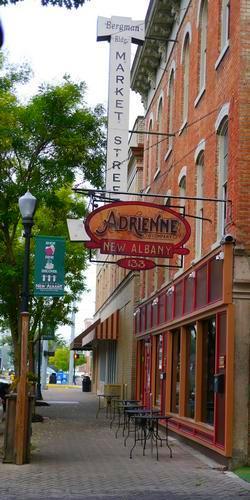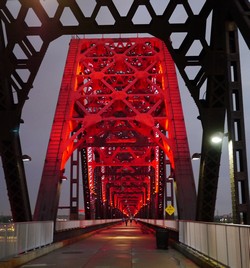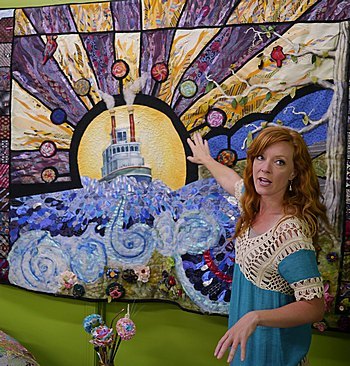
Long-time readers of HungryTravelers already know that we have a soft spot for the state of Kentucky. (David was born there and Pat’s a Kentucky Colonel.) On our recent visit to Louisville, though, we ventured across the Ohio River to explore the newfound hipster cachet of the southern Indiana communities that go by the catchy rubric of SoIN—as in SoIN to food, SoIN to you, SoIN to music, and so on. It was a tasty journey.
Sorry, folks: some history
 Geography is destiny. The Falls of the Ohio made Louisville possible—and necessary. The 26-foot drop in the Ohio River meant river traffic from the east had to unload at Louisville. Goods were then transported overland and reloaded downriver to make the journey to Cairo, Illinois, and south on the Mississippi River to the Gulf of Mexico. Founded in 1778 by George Rogers Clark, Louisville quickly became a great warehouse city and a manufacturing center for goods to sell downriver. (That’s bourbon, but more about that in other posts in this series.) The photo above right shows Louisville’s neon-lit entertainment district.
Geography is destiny. The Falls of the Ohio made Louisville possible—and necessary. The 26-foot drop in the Ohio River meant river traffic from the east had to unload at Louisville. Goods were then transported overland and reloaded downriver to make the journey to Cairo, Illinois, and south on the Mississippi River to the Gulf of Mexico. Founded in 1778 by George Rogers Clark, Louisville quickly became a great warehouse city and a manufacturing center for goods to sell downriver. (That’s bourbon, but more about that in other posts in this series.) The photo above right shows Louisville’s neon-lit entertainment district.
 Across the Ohio from Louisville, the small Indiana towns of Jeffersonville and New Albany were both carved out of a land grant to Louisville founder and Revolutionary War hero George Rogers Clark. Shipyards and railroads made them prosper. As the first free soil north of the Ohio, they were also powerful magnets on the Underground Railroad while Louisville still held one of the largest slave markets north of New Orleans. (The photo at right is New Albany, Indiana’s more laidback downtown.) For nearly a century, the two banks of the Ohio that had so much in common were divided by the political issues that led to the Civil War. Now they look, sound, and taste more like each other all the time. Together they represent the intersection of the South and the Midwest. They are the land of bourbon and biscuits, of blues and bluegrass, of people south and north steeped in their history but not held hostage by it.
Across the Ohio from Louisville, the small Indiana towns of Jeffersonville and New Albany were both carved out of a land grant to Louisville founder and Revolutionary War hero George Rogers Clark. Shipyards and railroads made them prosper. As the first free soil north of the Ohio, they were also powerful magnets on the Underground Railroad while Louisville still held one of the largest slave markets north of New Orleans. (The photo at right is New Albany, Indiana’s more laidback downtown.) For nearly a century, the two banks of the Ohio that had so much in common were divided by the political issues that led to the Civil War. Now they look, sound, and taste more like each other all the time. Together they represent the intersection of the South and the Midwest. They are the land of bourbon and biscuits, of blues and bluegrass, of people south and north steeped in their history but not held hostage by it.
Hands across the water
 A bridge is a powerful metaphor, and no fewer than eight of them link Louisville and SoIN. The one at top is the Abraham Lincoln Bridge, carrying I-65 north, but our favorite is the pedestrian Big Four Bridge (at right). It once carried the tracks of the Cleveland, Cincinnati, Chicago and St. Louis Railway line, hence the name. From the Louisville side, the ramp to the bridge is part of Louisville Waterfront Park. The landscaping is less dramatic on the Jeffersonville, Indiana, side, but access is easy—even for wheelchair users. The span is a little under a half mile (2,525 feet), and a casual stroll takes about 20 minutes. (Most of that time is spent climbing up and climbing down at the two ends.) It’s been open at both ends since May 2014, and is patrolled 24 hours a day to ensure safe passage for walkers, runners, rollers, and cyclists.
A bridge is a powerful metaphor, and no fewer than eight of them link Louisville and SoIN. The one at top is the Abraham Lincoln Bridge, carrying I-65 north, but our favorite is the pedestrian Big Four Bridge (at right). It once carried the tracks of the Cleveland, Cincinnati, Chicago and St. Louis Railway line, hence the name. From the Louisville side, the ramp to the bridge is part of Louisville Waterfront Park. The landscaping is less dramatic on the Jeffersonville, Indiana, side, but access is easy—even for wheelchair users. The span is a little under a half mile (2,525 feet), and a casual stroll takes about 20 minutes. (Most of that time is spent climbing up and climbing down at the two ends.) It’s been open at both ends since May 2014, and is patrolled 24 hours a day to ensure safe passage for walkers, runners, rollers, and cyclists.
Art on the rise
 Across the bridge from the bright lights of Louisville, look for a colorfully painted water tower. Just as the church towers of southern Indiana were beacons to seekers of freedom, the tower is a beacon to artists. It serves as a marker for a new arts and cultural district where galleries, shops, and artists’ studios are springing up. At right, public arts administrator Dawn Spyker shows a quilt made as a high school group art project to celebrate the Ohio, the great stream that unites as well as divides.
Across the bridge from the bright lights of Louisville, look for a colorfully painted water tower. Just as the church towers of southern Indiana were beacons to seekers of freedom, the tower is a beacon to artists. It serves as a marker for a new arts and cultural district where galleries, shops, and artists’ studios are springing up. At right, public arts administrator Dawn Spyker shows a quilt made as a high school group art project to celebrate the Ohio, the great stream that unites as well as divides.
In our explorations of SoIN and Louisville, we found another kind of artistry at work. Not only are the chefs plating up beautiful servings of Southern-inspired cuisine, the bartenders are working the local spirits hard to nice effect. And one of the things we enjoy about the bars in these parts—the folks creating drinks usually go by the handle of “bartender.” It’s a reminder that “mixologists” mostly live east of the Allegheny.
